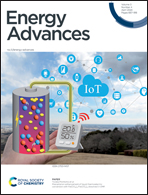Practical potential of suspension electrodes for enhanced limiting currents in electrochemical CO2 reduction†
Abstract
CO2 conversion is an important part of the transition towards clean fuels and chemicals. However, low solubility of CO2 in water and its slow diffusion cause mass transfer limitations in aqueous electrochemical CO2 reduction. This significantly limits the partial current densities towards any desired CO2-reduction product. We propose using flowable suspension electrodes to spread the current over a larger volume and alleviate mass transfer limitations, which could allow high partial current densities for CO2 conversion even in aqueous environments. To identify the requirements for a well-performing suspension electrode, we use a transmission line model to simulate the local electric and ionic current distributions throughout a channel and show that the electrocatalysis is best distributed over the catholyte volume when the electric, ionic and charge transfer resistances are balanced. In addition, we used electrochemical impedance spectroscopy to measure the different resistance contributions and correlated the results with rheology measurements to show that particle size and shape impact the ever-present trade-off between conductivity and flowability. We combine the modelling and experimental results to evaluate which carbon type is most suitable for use in a suspension electrode for CO2 reduction, and predict a good reaction distribution throughout activated carbon and carbon black suspensions. Finally, we tested several suspension electrodes in a CO2 electrolyzer. Even though mass transport limitations should be reduced, the CO partial current densities are capped at 2.8 mA cm−2, which may be due to engineering limitations. We conclude that using suspension electrodes is challenging for sensitive reactions like CO2 reduction, and may be more suitable for use in other electrochemical conversion reactions suffering from mass transfer limitations that are less affected by competing reactions and contaminations.

- This article is part of the themed collections: Research advancing UN SDG 7: Affordable and clean energy, Research advancing UN SDG 13: Climate Action and Energy Advances: Highlight UK & Europe


 Please wait while we load your content...
Please wait while we load your content...